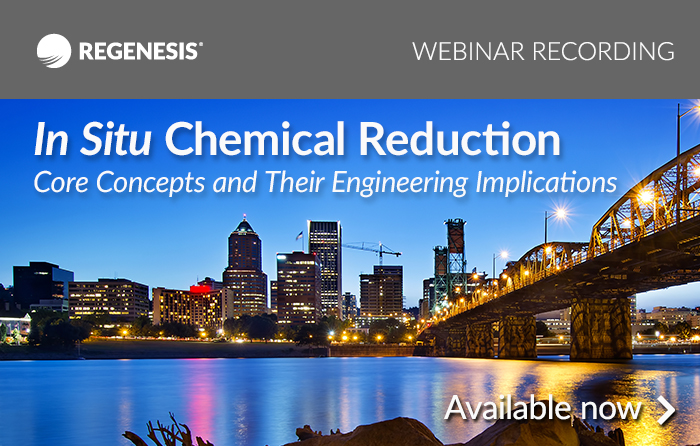In this webinar we are pleased to have a special guest presentation by Paul Tratnyek, PhD, Professor in the Division of Environmental and Biomolecular Systems (EBS) and Institute of Environmental Health (IEH), at the Oregon Health & Science University (OHSU). In this presentation he discusses in situ chemical reduction (ISCR), specifically with regard to its core concepts and their engineering implications. Recent groundwater remediation studies demonstrating that there can be an abiotic component to natural attenuation, together with the proliferation of remediation technologies like zero-valent iron, has led to the emergence of a general class of groundwater treatment processes known as “in situ chemical reduction” (ISCR). As the field of ISCR matures, it is developing “core concepts” that link fundamental understanding of the controlling processes to technology performance in the field.
This webinar features discussion of:
- Exploration of several core conceptual issues related to ISCR
- How oxidation-reduction potential (ORP) is related to dechlorination rates
- What controls the amount of intermediate “stall” dechlorination products like dichloroethene and vinyl chloride
About the Presenters:
 Paul Tratnyek, PhD
Professor, Oregon Health & Science University (OHSU)
Dr. Paul Tratnyek is Professor in the Division of Environmental and Biomolecular Systems (EBS) and Institute of Environmental Health (IEH), at the Oregon Health & Science University (OHSU). He received his PhD in Applied Chemistry from the Colorado School of Mines (CSM) in 1987; served as a National Research Council Postdoctoral Fellow at the U.S. Environmental Protection Agency Laboratory in Athens, GA (ERD-Athens) during 1988; and as a Research Associate at the Swiss Federal Institute for Water Resources and Water Pollution Control (EAWAG) from 1989 to 1991. Dr. Tratnyek’s research concerns the physico-chemical processes that control the fate and effects of environmental substances, including minerals, metals (for remediation), organics (as contaminants), and nanoparticles (for remediation, as contaminants, and in biomedical applications). Dr. Tratnyek is best known for his work on the degradation of groundwater contaminants with zero-valent metals, but his interests extend to all aspects of contaminant reduction and oxidation (redox) in all aquatic media. Some of his recent work emphasizes the fate/remediation of emerging contaminants (e.g., nanoparticles and 1,2,3-trichloropropane) and next generation energetic compounds (e.g., DNAN).
Paul Tratnyek, PhD
Professor, Oregon Health & Science University (OHSU)
Dr. Paul Tratnyek is Professor in the Division of Environmental and Biomolecular Systems (EBS) and Institute of Environmental Health (IEH), at the Oregon Health & Science University (OHSU). He received his PhD in Applied Chemistry from the Colorado School of Mines (CSM) in 1987; served as a National Research Council Postdoctoral Fellow at the U.S. Environmental Protection Agency Laboratory in Athens, GA (ERD-Athens) during 1988; and as a Research Associate at the Swiss Federal Institute for Water Resources and Water Pollution Control (EAWAG) from 1989 to 1991. Dr. Tratnyek’s research concerns the physico-chemical processes that control the fate and effects of environmental substances, including minerals, metals (for remediation), organics (as contaminants), and nanoparticles (for remediation, as contaminants, and in biomedical applications). Dr. Tratnyek is best known for his work on the degradation of groundwater contaminants with zero-valent metals, but his interests extend to all aspects of contaminant reduction and oxidation (redox) in all aquatic media. Some of his recent work emphasizes the fate/remediation of emerging contaminants (e.g., nanoparticles and 1,2,3-trichloropropane) and next generation energetic compounds (e.g., DNAN).
 John Freim, PhD
Director of Materials Science, REGENESIS
Dr. John Freim is well-known throughout the environmental industry for his work in developing break-through in situ chemical reduction (ISCR) technologies successfully employed throughout the environmental remediation industry. Dr. Freim has over 30 years of expertise in materials processing, and 15 years in the environmental remediation industry, and is leading the establishment of the first REGENESIS state-of-the-art colloidal product manufacturing facility. In his role with REGENESIS, Dr. Freim is responsible for the manufacture of colloidal materials, including PlumeStop® Liquid Activated Carbon™, colloidal iron, and new products used in environmental remediation. Before joining REGENESIS, Dr. Freim founded and served as President of OnMaterials, a company that specialized in the affordable manufacture and application of zero-valent iron (ZVI) remedial amendments for soil and groundwater remediation, which resulted in the treatment of hundreds of environmentally impacted sites. Dr. Freim received a PhD in Materials Science from the University of California San Diego (UCSD) and a B.S. in Chemical Engineering from the University of Illinois at Urbana Champaign.
John Freim, PhD
Director of Materials Science, REGENESIS
Dr. John Freim is well-known throughout the environmental industry for his work in developing break-through in situ chemical reduction (ISCR) technologies successfully employed throughout the environmental remediation industry. Dr. Freim has over 30 years of expertise in materials processing, and 15 years in the environmental remediation industry, and is leading the establishment of the first REGENESIS state-of-the-art colloidal product manufacturing facility. In his role with REGENESIS, Dr. Freim is responsible for the manufacture of colloidal materials, including PlumeStop® Liquid Activated Carbon™, colloidal iron, and new products used in environmental remediation. Before joining REGENESIS, Dr. Freim founded and served as President of OnMaterials, a company that specialized in the affordable manufacture and application of zero-valent iron (ZVI) remedial amendments for soil and groundwater remediation, which resulted in the treatment of hundreds of environmentally impacted sites. Dr. Freim received a PhD in Materials Science from the University of California San Diego (UCSD) and a B.S. in Chemical Engineering from the University of Illinois at Urbana Champaign.


